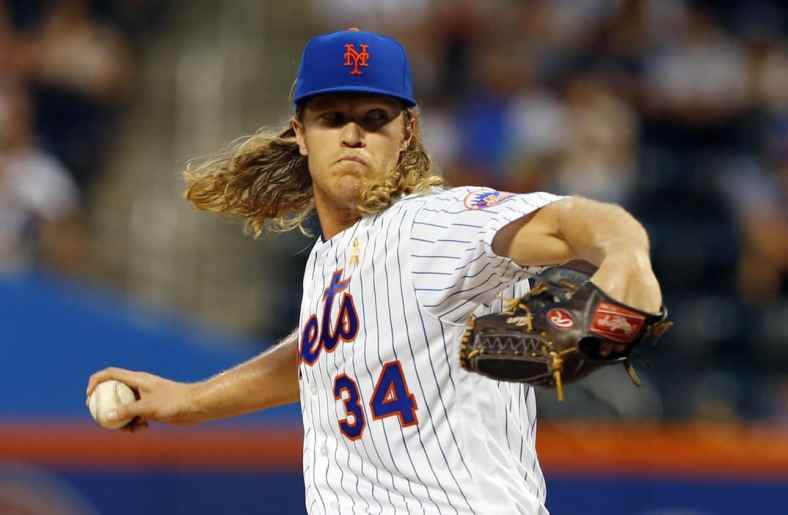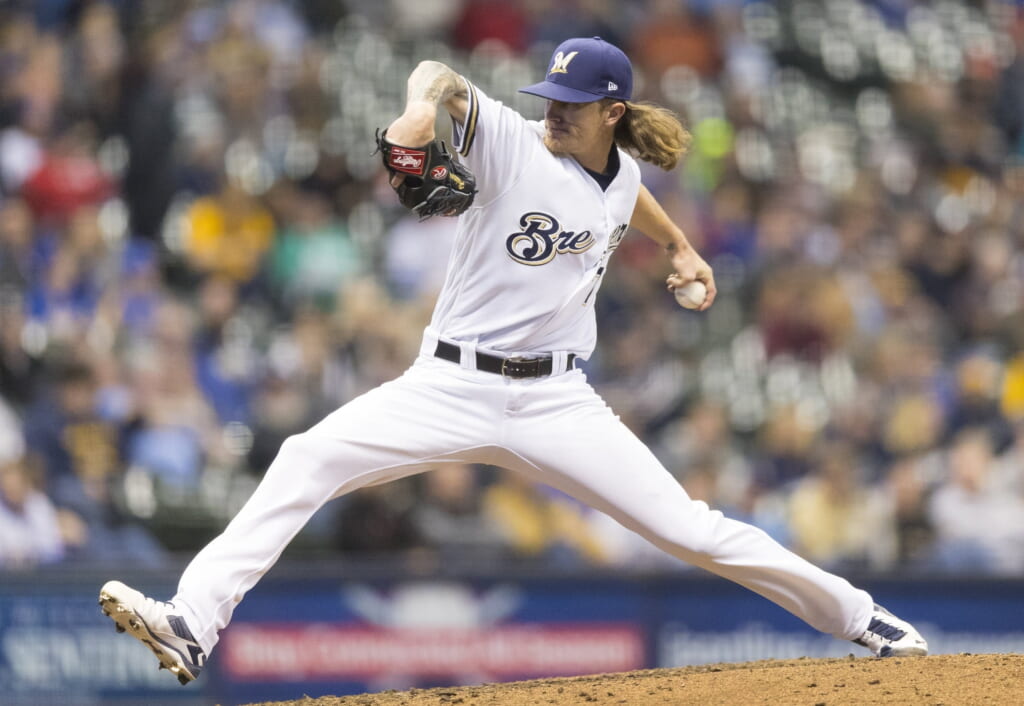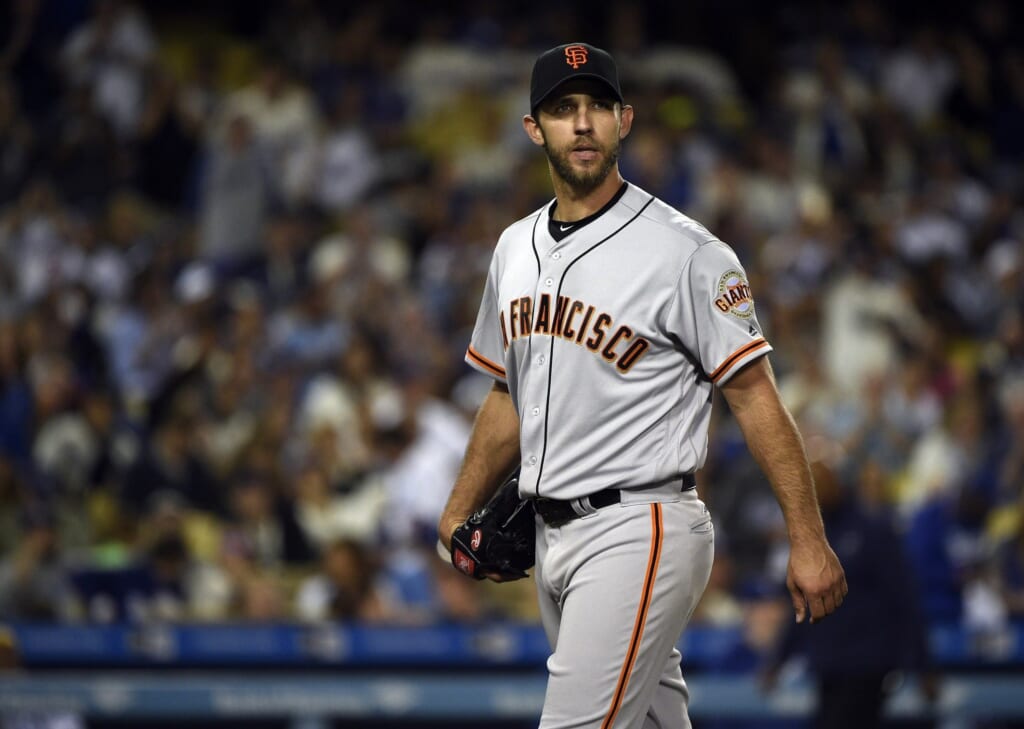
Some MLB pitchers already stand on the rubber with a significant psychological advantage over opposing hitters. Whether because of their size, demeanor or just their pure stuff, they make every at-bat a tremendous challenge that’s a cut above the rest.
Stepping into the batter’s box can already feel intimidating. Even for the eldest of MLB veterans, standing alone in a small box with tens of thousands of people staring down watching and waiting to see if you succeed or fail.
For many hitters, failure is the result more than 65 percent of the time, and with that in the back of your mind, the pressure can build up even more in that moment.
That’s just in any normal at-bat. But when a hitter steps into the box to face one of following 10 pitchers, the experience is even more daunting.
These are the most intimidating pitchers in baseball today.
Max Scherzer, starting pitcher, Washington Nationals
On reputation alone, Scherzer steps onto the mound with a edge. The intimidation factor starts before the game does, when opposing hitters look at the schedule and see they have to face a three-time Cy Young award winner and one of baseball’s best strikeout artists.
This season, Scherzer is taking the intimidation factor to another level. Mentally when you step into the box against a pitcher who strikes out over 40 percent of the batters he faces, you’re already at a disadvantage. With everything going on around you, tens of thousands of people watching you play a game where hitters routinely fail more often than not, you know against Scherzer the odds of embarrassing yourself with a swinging strikeout are dramatically higher.
The thought in the back of a hitter’s mind that they are facing Scherzer is already intimidating. You have to be nearly perfect even to get a single off of him. When you add in Scherzer’s intensity — he’s one of the most fiery and passionate pitchers in baseball and his stare down of the hitter is terrifying — it just makes facing him even worse. At 6-foot-3 and 215 pounds he’s a pitcher with a repertoire and fire that would leave most liking their odds better against another man.
Josh Hader, relief pitcher, Milwaukee Brewers

As with Scherzer, Hader’s physical frame isn’t one that strikes fear into an opponent. While he is 6-foot-3, he weighs under 190 pounds soaking wet, and that certainly doesn’t give the batter any uneasy feeling when in the box.
So the hitter stands in the batter’s box, sizes up Hader and waits for the pitch to come. It’s a nasty 80-mph slider that buckles the batter’s knees and puts him down in the count right at the start. The next pitch is a 94 mph fastball that paints the inside zone for strike two.
As a batter, you’re already down 0-2 and this thin pitcher with long hair is just toying with you. A strike away from walking back to the dugout with your head tucked down, the hitter takes a moment to gather himself then prepares himself again. Hader goes back to his wicked slider, this time in the dirt and an overwhelming force overpowers the batter to swing and miss at a pitch he wouldn’t make contact with even with a golf club.
Time and time again, Hader does exactly this. He might only use two pitches, and even when batters know what’s coming, they still have no chance against the southpaw’s fastball-slider combo. This is a reliever who struck out eight in 2 2/3 innings of relief against Cincinnati and has 56 strikeouts in 27 1/3 innings this season. In the late innings, a batter can only hope he doesn’t see Hader’s locks come out of the bullpen as he prepares for his at-bat.
Noah Syndergaard, starting pitcher, New York Mets
When you hear the nickname “Thor” as an opposing batter, you immediately think of a mammoth being, whose frame stands looming over people and possesses the power to deliver a mammoth punch.
In the case of Syndergaard, who draws the very same nickname, he certainly backs up the impression with a 6-foot-6 frame at 240 pounds. He also packs an average fastball velocity over 97 mph and a knockout slider that powers in at 92-plus miles per hour.
Of course, it’s critical to factor in the hair with Thor. With blonde locks that stretch down to his shoulders and swing in the air through Syndergaard’s delivery, facing him is an entire experience in itself. After missing most of last season on the disabled list, the southpaw is back dropping the hammer against his opponents and sending hitters back to the dugout with sulking shoulders, with ease.
Aroldis Chapman, relief pitcher, New York Yankees
Visualize stepping into the batter’s box and seeing Chapman in front of you, ready to wind up and unleash his 100-plus-mph fastball. Unlike with most pitchers, your greatest fear isn’t striking out. Instead, your greatest fear is that Chapman’s location is off by just a hair and that fastball drills you.
According to MLB.com’s StatCast, Chapman’s fastest pitch this season came on a 130.3 mph four-seam fastball that hit Boston Red Sox outfielder Jackie Bradley Jr. in the side. Any time you get hit by a pitch it hurts, but to get hit by a baseball going 103.3 mph is a whole new level of pain.
Just ask Tampa Bay Rays prospect Jake Cronenworth, who took a 98 mph fastball off his side during spring training (the aftermath was not pretty).
Chapman can still strike you out with ease, and he’s turning in one of the best seasons in his career thus far. But compared to the fear of potentially getting hit by his fastball, being struck out by the closer doesn’t seem so bad anymore.
Chris Sale, starting pitcher, Boston Red Sox

A pitcher already carries the height advantage on a batter by standing 10 inches above him on the pitcher’s mound. With their frame looming over the batter, some of the game’s tallest pitchers in recent history are put at an even greater advantage for intimidating batters.
Standing at 6-foot-6, Sale’s frame is already an intimidating presence on the mound. It’s something pitchers like Michael Pineda, at 6-foot-7, know how to take advantage of even with lesser stuff and reputation.
In Sale’s case, he pairs his towering presence on the mound with Cy Young-caliber stuff that allows him to strike out batters with ease and make them look foolish chasing pitches in and out of the zone on a regular basis. He is the combination of size, reputation and stuff that makes facing him all the more daunting for opposing hitters.
Dellin Betances, relief pitcher, New York Yankees
From an intimidation standpoint, Betances is a combination of Chapman and Sale. The 30-year-old is one of the tallest active pitchers in baseball at 6-foot-8 and tipping the scales at 260-plus pounds. This can already serve as a psychological advantage over the small hitter in the batter’s box.
Now pair that with a 97-plus mph fastball and inconsistent command, and it all makes for stepping into the box to face him a test of your physical and mental strength. While Betances’ command has improved this year, his fastball velocity and monstrous size remains. Keep in mind, he also hit 11 batters in 59 2/3 innings last season, so a hitter can never feel very comfortable whenever they face him.
Justin Verlander, starting pitcher, Houston Astros
Since Verlander made the decision to approve the trade to Houston, he has transformed back into one of the best pitchers in baseball. In 15 starts with the Astros, Verlander’s ERA stands at 1.05 with a 0.69 WHIP. He’s also joined some elite company by combining multiple no-hitters with 2,500-plus career strikeouts.
Just think about being a hitter and stepping between the white lines to face the favorite for this year’s A.L. Cy Young award. Only 19.9 percent of the 376 batters Verlander has faced with the Astros reached base safely.
Now add in his increased fastball velocity — back up to the 94.5-plus mph he was throwing back in 2011 — and pair it with his overall repertoire, ability to locate his pitches and his physical presence and reputation on the mound.
It doesn’t matter if you’re Mike Trout, who owns a .074 batting average versus Verlander in 27 at-bats, or a 22-year-old hitter just called up from the minors. There are few things more intimidating in baseball than facing Kate Upton’s husband.
Madison Bumgarner, starting pitcher, San Francisco Giants

Injuries the past two years have limited our exposure to Bumgarner, but the left-handed pitcher still offers plenty of intimidation tactics when he steps on the mound to face a batter.
For one, Bumgarner’s personality reflects a pitcher who is never afraid to get in a hitter’s face for a confrontation. Based on confrontations with Los Angeles Dodgers outfielder Yasiel Puig and Tampa Bay Rays outfielder Carlos Gomez, among many others, Bumgarner is clearly ready to go after a batter at any moment. Given his size at 6-foot-5 and 250 pounds, it’s one large human being coming after you when he gets angry.
It doesn’t stop there for the 28-year-old from North Carolina. Because before Bumgarner confronts a player verbally, he’ll use the same repertoire and command of pitches that helped him deliver one of the greatest stretches of postseason brilliance in the history of baseball.
When you factor in his size, stuff and reputation as a pitcher, he becomes a very intimidating hurler whom you do not want to piss off if you’re an opposing batter.
Clayton Kershaw, starting pitcher, Los Angeles Dodgers
As with Bumgarner, frequent trips to the disabled list have robbed baseball fans of the exposure to Kershaw’s dominance they deserve. In those stretches when fans do get to witness him though, he is arguably the most intimidating pitcher in baseball.
At 6-foot-4, Kershaw certainly has plenty of size going for him on the mound to give him an added advantage. While he doesn’t blow away batters with a fastball in the high-90s, he uses his curveball as arguably the most lethal pitch in the game to turn opposing batters into dust.
There is a risk of Kershaw slipping off this list in the near future. If he continues to miss time or be limited, whether due to his back or an arm injury, then the man who was once the greatest pitcher in baseball could fall into a territory no one wants to see.
Craig Kimbrel, relief pitcher, Boston Red Sox
As a hitter, the pressure is already on with your team trailing in the ninth inning of an important game. Then you see the familiar beard run out from the bullpen in Fenway Park and take the mound — one of the best relievers in baseball history.
Kimbrel continues to maintain his dominance out of the bullpen and has already surpassed 300 saves by his age-29 season. He owns the second-best strikeout rate (14.69 K/9) for relievers since 1950 and is on pace to one day finish his career with 600-plus saves.
Even with a slightly diminished fastball velocity, Kimbrel can still bring the heat and averages 96-plus mph on that pitch this season. Pair that with his unorthodox but now recognizable look on the mound — a stare down of the batter and his body hunched over with his throwing arm hanging down — and he makes his presence felt by opposing hitters.
The right-handed closer has shut down teams in the ninth inning for years, driving the nail in the coffin to end their hopes of pulling off the comeback. As a hitter, part of you almost accepts that it’s over when you see him staring you down.